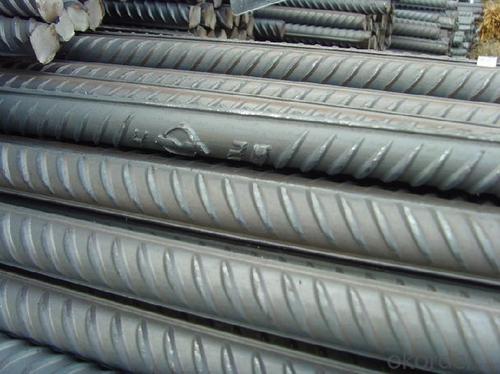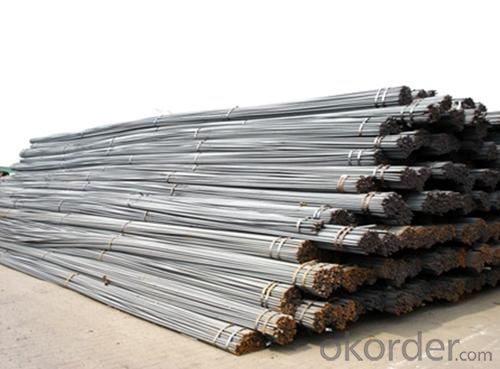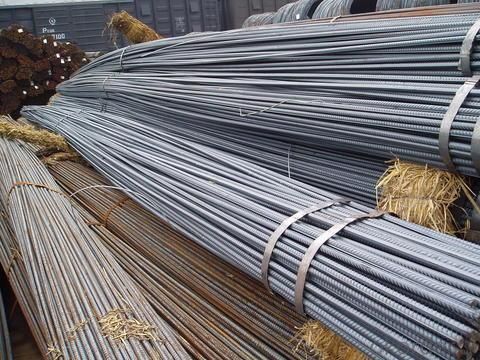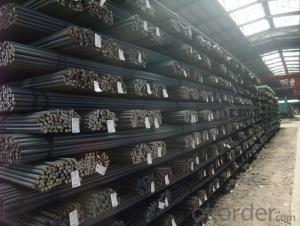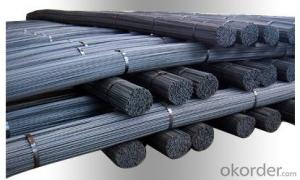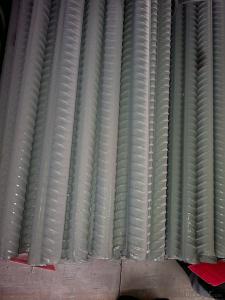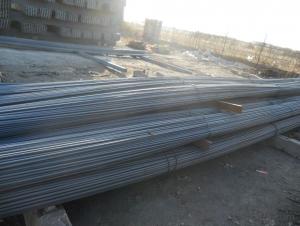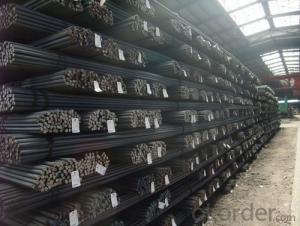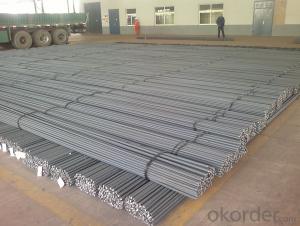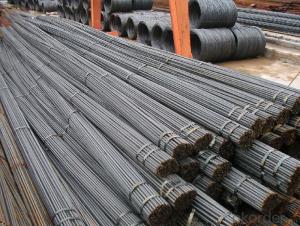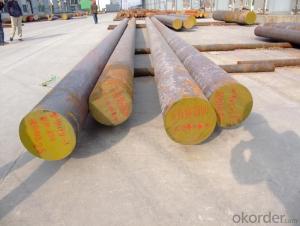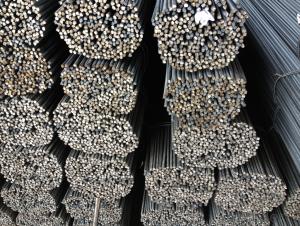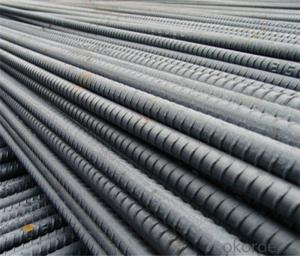Deformed Steel Bar, Iron Rods for Construction or Concrete
- Loading Port:
- Tianjin
- Payment Terms:
- TT or LC
- Min Order Qty:
- 25 m.t.
- Supply Capability:
- 35000 m.t./month
OKorder Service Pledge
OKorder Financial Service
You Might Also Like
Product Description:
OKorder is offering Deformed Steel Bar, Iron Rods for Construction or Concrete at great prices with worldwide shipping. Our supplier is a world-class manufacturer of steel, with our products utilized the world over. OKorder annually supplies products to European, North American and Asian markets. We provide quotations within 24 hours of receiving an inquiry and guarantee competitive prices.
Product Applications:
Deformed Steel Bar, Iron Rods for Construction or Concrete are ideal for structural applications and are widely used in the construction of buildings and bridges, and the manufacturing, petrochemical, and transportation industries.
Product Advantages:
OKorder's Deformed Steel Bar, Iron Rods for Construction or Concrete are durable, strong, and resist corrosion.
Main Product Features:
· Premium quality
· Prompt delivery & seaworthy packing (30 days after receiving deposit)
· Corrosion resistance
· Can be recycled and reused
· Mill test certification
· Professional Service
· Competitive pricing
Product Specifications:
Certificates: CE & ISO9001:2000
Material: hrhrb400 ,hrb500, BS4449, ASTM A615, SD400
length:6-12
Size: 6mm-40mm
HRB 400E Hot rolled steel rebar
Type | steel rebar |
Standard Grade | a. GB1499.2-2007, HRB335, HRB400E, etc. |
b. ASTM A615 Gr.40, Gr.60, etc. | |
c. BS4449/1997, etc. | |
Diameter | 6mm-32mm etc. |
Length | 6m, 8m, 9m,12m as standard |
Application | construction industry with all types of reinforced concrete structures and so on |
Packing | standard export packing, or as per customers' requirement |
Quality | First quality |
Delivery time | Right now after the deposit. |
Others | 1. all the production process are made under the ISO 9001:2001 strictly |
2. our products conform to all the standards | |
3. we can offer special specification products as per our customers | |
FAQ:
Q1: Why buy Materials & Equipment from OKorder.com?
A1: All products offered byOKorder.com are carefully selected from China's most reliable manufacturing enterprises. Through its ISO certifications, OKorder.com adheres to the highest standards and a commitment to supply chain safety and customer satisfaction.
Q2: How do we guarantee the quality of our products?
A2: We have established an advanced quality management system which conducts strict quality tests at every step, from raw materials to the final product. At the same time, we provide extensive follow-up service assurances as required.
Q3: How soon can we receive the product after purchase?
A3: Within three days of placing an order, we will begin production. The specific shipping date is dependent upon international and government factors, but is typically 7 to 10 workdays.
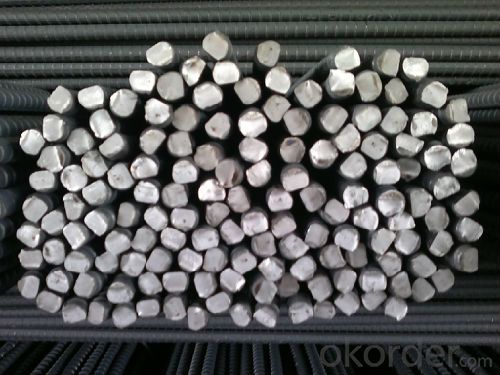
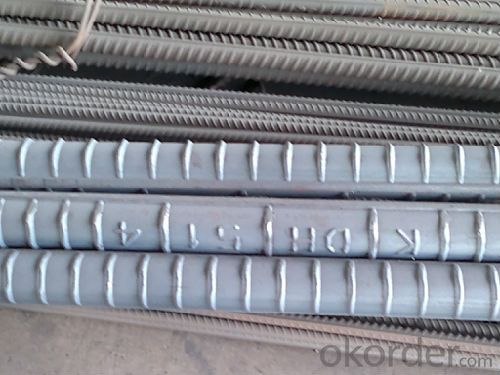
- Q: What is the effect of chloride ions on steel rebars?
- The presence of chloride ions in the environment can have a detrimental effect on steel rebars. Chloride ions can penetrate the protective oxide layer on the surface of the steel and react with the iron atoms, leading to the formation of iron chloride compounds. These compounds are highly corrosive and can cause the rebars to rust and eventually weaken. This corrosion process, known as chloride-induced corrosion, can significantly reduce the structural integrity and lifespan of steel rebars, posing a risk to the overall stability of reinforced concrete structures. Therefore, it is crucial to protect steel rebars from chloride exposure through proper design, construction, and maintenance practices to ensure their long-term durability and safety.
- Q: What is the process of connecting steel rebars to structural members?
- The process of connecting steel rebars to structural members is typically done through a method called rebar tying. This involves placing the rebars in the desired positions within the structural member, and then using wire or steel tie rods to securely fasten the rebars to the member. The ties are typically twisted or tightened to ensure a strong and reliable connection between the rebars and the structural member. This process is crucial in reinforcing concrete structures and ensuring their strength and stability.
- Q: How are steel rebars connected or joined together?
- Steel rebars are typically connected or joined together using different methods, depending on the specific application and structural requirements. The most common methods of connecting steel rebars are: 1. Overlapping: This method involves overlapping two rebars to create a continuous length of reinforcement. The overlapping length should meet the specified design requirements and is typically secured with steel tie wires or mechanical connectors. 2. Welding: Steel rebars can be joined together through welding, which involves melting the ends of the rebars and fusing them together using heat. Welding is a suitable method for connecting rebars in pre-fabricated structures or where high strength and durability are required. 3. Mechanical couplers: Mechanical couplers are pre-fabricated devices that provide a threaded connection between two rebars. These couplers are typically screwed onto the ends of the rebars, creating a strong and reliable connection. Mechanical couplers are commonly used in construction projects where fast installation and ease of use are important. 4. Lap splicing: Lap splicing involves connecting two rebars by overlapping them and securing the overlap with steel tie wires or mechanical connectors. This method is widely used in reinforced concrete structures and provides adequate strength and continuity. 5. Grouted splicing: In grouted splicing, the ends of two rebars are embedded into a sleeve or coupling filled with grout or epoxy resin. This method ensures a strong bond between the rebars, providing enhanced load transfer and corrosion resistance. It is important to note that the connection method used for steel rebars should comply with the applicable building codes and structural design specifications to ensure the overall integrity and safety of the structure.
- Q: How do steel rebars improve the flexural strength of concrete?
- Concrete's flexural strength is enhanced by the presence of steel rebars, which reinforce the material and resist tensile forces. Although concrete is strong in compression, it lacks the same strength in tension, making it prone to cracking and failure under bending or other flexural stresses. The addition of steel rebars to the concrete results in a composite material with improved flexural strength. These rebars serve as reinforcement, absorbing and distributing tensile forces throughout the structure. When subjected to bending, the rebars counteract the tension, effectively preventing cracks from forming and spreading. Typically, the rebars are strategically placed in areas where tensile stresses are anticipated, such as the bottom of a beam or the tension face of a slab. Their purpose is to provide sufficient strength to bear the tensile forces and safeguard the concrete from failure. The bond between the rebars and the concrete is essential for ensuring effective transfer of loads from the concrete to the steel reinforcement. Furthermore, the incorporation of rebars allows for the design of slimmer and more efficient concrete elements. By providing the necessary tensile strength, the amount of concrete required can be reduced, resulting in cost savings and lighter structures. The combination of concrete and steel rebars maximizes the material properties of both components, creating a composite material that exhibits strength in both compression and tension. In summary, steel rebars significantly enhance the flexural strength of concrete by reinforcing it against tensile forces, thereby preventing cracking and failure. This reinforcement enables the design of more efficient and durable structures.
- Q: Are steel rebars susceptible to fatigue failure?
- Yes, steel rebars are susceptible to fatigue failure. Fatigue failure occurs when a material undergoes repeated cyclic loading, causing cracks to initiate and propagate, leading to eventual failure. Steel rebars, which are commonly used in construction to reinforce concrete structures, can experience fatigue failure if they are subjected to repeated loading and unloading cycles over an extended period. To prevent fatigue failure, proper design considerations, such as adequate reinforcement, avoidance of high stress concentrations, and regular maintenance, should be implemented.
- Q: Can steel rebars be galvanized for additional protection?
- Yes, steel rebars can be galvanized for additional protection. Galvanizing is a process where a layer of zinc is applied to the surface of the steel rebar. This layer acts as a protective barrier, preventing corrosion and extending the lifespan of the rebar. Galvanized steel rebars are commonly used in construction projects where exposure to moisture, chemicals, or other corrosive elements is expected. The galvanizing process involves dipping the steel rebars into a bath of molten zinc or applying a zinc-rich coating through a hot-dip galvanizing or electroplating process. This results in a durable and corrosion-resistant coating that provides additional protection to the steel rebar, increasing its longevity and reducing maintenance requirements. Overall, galvanizing steel rebars is an effective method of enhancing their protection against corrosion and ensuring their long-term durability in various applications.
- Q: How are steel rebars protected against extreme weather conditions?
- Steel rebars are protected against extreme weather conditions through various methods. One common method is the application of protective coatings. These coatings act as a barrier between the rebar and the environment, preventing the steel from being exposed to moisture, oxygen, and other corrosive elements. These coatings can include epoxy, zinc, or concrete-based materials. Another method of protection is the use of corrosion inhibitors. These inhibitors are added to the concrete during the mixing process and work by forming a protective layer on the surface of the rebar. This layer helps to prevent the penetration of moisture and other corrosive substances into the steel. Additionally, proper concrete cover is crucial for protecting rebars against extreme weather conditions. Adequate thickness of the concrete cover ensures that the rebars are not directly exposed to harsh weather elements. This cover acts as a shield, providing a physical barrier that prevents moisture and other corrosive agents from reaching the steel. Furthermore, design considerations are taken into account to protect rebars from extreme weather conditions. Engineers may specify the use of stainless steel rebars or epoxy-coated rebars in areas prone to extreme weather or high humidity. These materials have enhanced corrosion resistance properties, making them more suitable for such environments. Regular maintenance and inspection are also essential for ensuring the long-term protection of rebars against extreme weather conditions. Inspections can identify any signs of corrosion or damage, allowing for timely repairs and preventative measures to be taken. In summary, steel rebars are protected against extreme weather conditions through the application of protective coatings, the use of corrosion inhibitors, proper concrete cover, and the consideration of design factors. Regular maintenance and inspection also play a crucial role in ensuring their protection.
- Q: How are steel rebars coated with epoxy?
- Steel rebars are coated with epoxy through a process called fusion bonding. In this process, the rebars are first cleaned and preheated, and then a layer of epoxy powder is applied to their surface. The rebars are then heated to a high temperature, causing the epoxy powder to melt and fuse with the steel, creating a durable and protective coating.
- Q: What are the main properties of steel rebars?
- Steel rebars, also known as reinforcing bars, are essential components in reinforced concrete structures. They possess several key properties that make them ideal for providing strength and durability to these structures. 1. Strength: One of the primary properties of steel rebars is their high tensile strength. They can withstand significant pulling forces and provide the necessary reinforcement to resist cracking and structural failure in concrete. 2. Ductility: Steel rebars exhibit excellent ductility, meaning they can deform without fracturing under stress. This property allows them to absorb energy during seismic events or other extreme loads, enhancing the overall structural performance and resilience of the reinforced concrete. 3. Corrosion resistance: Steel rebars are typically manufactured with a protective layer, such as epoxy or galvanized coating, to prevent corrosion. This property is crucial as exposure to moisture, chloride ions, and other corrosive elements can significantly weaken the rebars and compromise the integrity of the structure. 4. Weldability: Steel rebars can be easily welded together, allowing for efficient and effective construction. This property ensures that rebars can be connected to form a continuous and robust reinforcement network, enhancing the overall strength and stability of the concrete structure. 5. Thermal compatibility: Steel rebars have similar thermal expansion and contraction properties to concrete, minimizing the risk of cracking or structural damage due to temperature changes. This compatibility ensures the long-term durability and stability of reinforced concrete structures. 6. Availability and cost-effectiveness: Steel rebars are widely available and relatively cost-effective compared to other reinforcing materials. This affordability, combined with their excellent mechanical properties, makes them a popular choice for structural reinforcement across various construction projects. In conclusion, the main properties of steel rebars include high tensile strength, ductility, corrosion resistance, weldability, thermal compatibility, and cost-effectiveness. These properties make steel rebars indispensable for providing structural strength and durability to reinforced concrete structures.
- Q: How are steel rebars different from steel mesh?
- Steel rebars and steel mesh are both reinforcement materials used in construction, but they differ in their shape and application. Steel rebars are long, slender bars with a round or deformed surface, primarily used to reinforce concrete structures like beams, columns, and walls. They provide tensile strength and prevent cracking or failure in concrete elements. On the other hand, steel mesh consists of interconnected wires forming a grid-like pattern and is commonly used to reinforce concrete slabs, pavements, and foundations. Mesh provides uniform support and distributes loads evenly, enhancing the overall strength and durability of the concrete. So, while both serve the purpose of reinforcement, rebars are ideal for vertical structures, whereas mesh is more suitable for horizontal applications.
Send your message to us
Deformed Steel Bar, Iron Rods for Construction or Concrete
- Loading Port:
- Tianjin
- Payment Terms:
- TT or LC
- Min Order Qty:
- 25 m.t.
- Supply Capability:
- 35000 m.t./month
OKorder Service Pledge
OKorder Financial Service
Similar products
Hot products
Hot Searches
Related keywords



